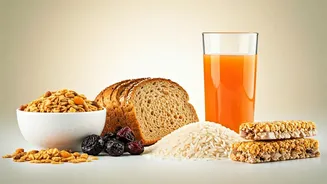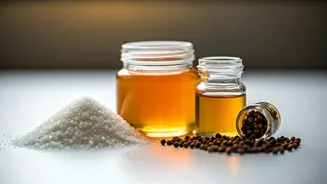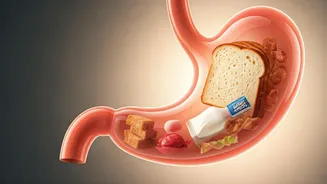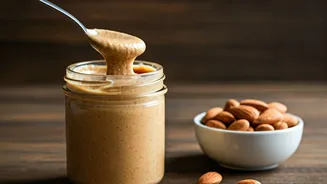Whole Grains' Hidden Impact
The perception of whole grains as universally beneficial often overlooks their potential to influence blood sugar. While whole grains are superior to refined
grains because of their fiber and nutrient content, they can still cause blood sugar levels to rise, especially when consumed in large portions. For instance, a serving of whole-wheat bread can sometimes have a similar effect on blood sugar as white bread. Factors like the processing method and individual metabolism determine how quickly glucose enters the bloodstream. Furthermore, combining whole grains with other foods, like proteins and healthy fats, can help mitigate these effects. It's a matter of choosing them over refined options but remaining mindful of portion sizes and personal responses. Considering the glycemic index of specific whole grains, such as brown rice compared to white rice, adds another layer to this understanding, helping one make better food choices.
Fruit’s Sugar Content
The natural sugars found in fruits, while often paired with beneficial vitamins and fiber, can nonetheless lead to a rise in blood sugar. The extent of this impact can differ greatly based on the type of fruit and its ripeness. Fruits like bananas and mangoes, for instance, are naturally high in sugar and have the potential to raise blood glucose levels significantly. Conversely, fruits with lower sugar content, such as berries, may have a more moderate effect, partly due to their fiber content, which slows down sugar absorption. Understanding the glycemic load of various fruits is key, as it considers both the quantity of carbohydrates and how quickly they raise blood sugar. Furthermore, eating fruit in moderation and combining it with protein or healthy fats can help to lessen the impact on blood sugar. Personal responses also play a role; some people may tolerate certain fruits better than others.
Sweetened Yogurt Concerns
Yogurt, particularly the flavored and sweetened varieties, often contains added sugars that can cause blood sugar levels to spike. While plain yogurt is typically a good source of protein and probiotics, the addition of sweeteners, such as high-fructose corn syrup, drastically changes the nutritional profile. These added sugars are quickly absorbed into the bloodstream, leading to rapid increases in blood glucose. Even yogurts marketed as “low-fat” or “healthy” can be high in sugar, as manufacturers often compensate for the loss of flavor with added sweeteners. Carefully reading food labels, paying attention to the grams of sugar, and considering the ingredients list are vital steps. For those seeking a healthier option, choosing plain yogurt and adding your own natural sweeteners like fruits, or opting for unsweetened options, can give you similar benefits without a surge in blood sugar. Exploring different yogurt types and their sugar content, such as Greek yogurt versus regular yogurt, can give you a better understanding to make informed choices.
Dried Fruits vs Fresh
Dried fruits are commonly considered a convenient and nutritious snack, but they have a higher concentration of sugars than their fresh counterparts, which can significantly affect blood sugar levels. When fruits are dried, the water content is removed, which concentrates the natural sugars and carbohydrates. This means that a small portion of dried fruit can contain a substantial amount of sugar, leading to a more rapid spike in blood glucose compared to eating the same amount of fresh fruit. Examples include raisins, dates, and dried mangoes. The fiber content in dried fruits is still present, which helps to slow down the absorption of sugar, but the high concentration of sugar means the impact can still be significant. Moderation and portion control are crucial when consuming dried fruits. Considering them as a treat and pairing them with sources of protein or healthy fats can help minimize the effects on blood sugar. Exploring the sugar content differences between various dried fruit options is also advisable.
Breakfast Cereals Analyzed
Many breakfast cereals, even those marketed as healthy options, are loaded with added sugars, leading to potential blood sugar spikes. These cereals often include refined grains and high levels of added sugars, such as sucrose or high-fructose corn syrup, which are quickly digested and absorbed into the bloodstream. This rapid absorption can lead to a quick elevation in blood sugar levels. Fiber content does impact the impact on blood sugar, but many cereals are low in fiber, leading to minimal effects. Reading labels carefully is important, focusing on the added sugars per serving and the ingredients list. Choosing cereals with minimal added sugars, higher fiber content, and whole grains can be more beneficial. Pairing your cereal with a source of protein and healthy fats, such as nuts or eggs, can slow down the digestion of carbohydrates and help prevent blood sugar spikes. Selecting cereals with a low glycemic index and glycemic load can also assist in making better choices.
Processed Foods Beware
Processed foods are often packed with hidden sugars, which can lead to blood sugar imbalances. Foods like sauces, condiments, and pre-packaged snacks frequently contain high levels of added sugars, even if they don't taste sweet. Ketchup, salad dressings, and flavored snacks often use sugars to enhance flavor and shelf life. These added sugars contribute to quick rises in blood glucose levels, potentially leading to insulin resistance and other health issues. Reading labels becomes crucial, looking beyond the primary ingredients to identify hidden sugars. Common names for added sugars include high-fructose corn syrup, dextrose, and sucrose. Choosing unprocessed or minimally processed foods, such as fresh vegetables and homemade dressings, can help reduce sugar intake. Understanding the nutritional composition of processed foods and their impact on blood sugar levels is a good first step towards making healthier dietary decisions. Comparing the ingredients of different processed food brands is another way to make healthier choices.











